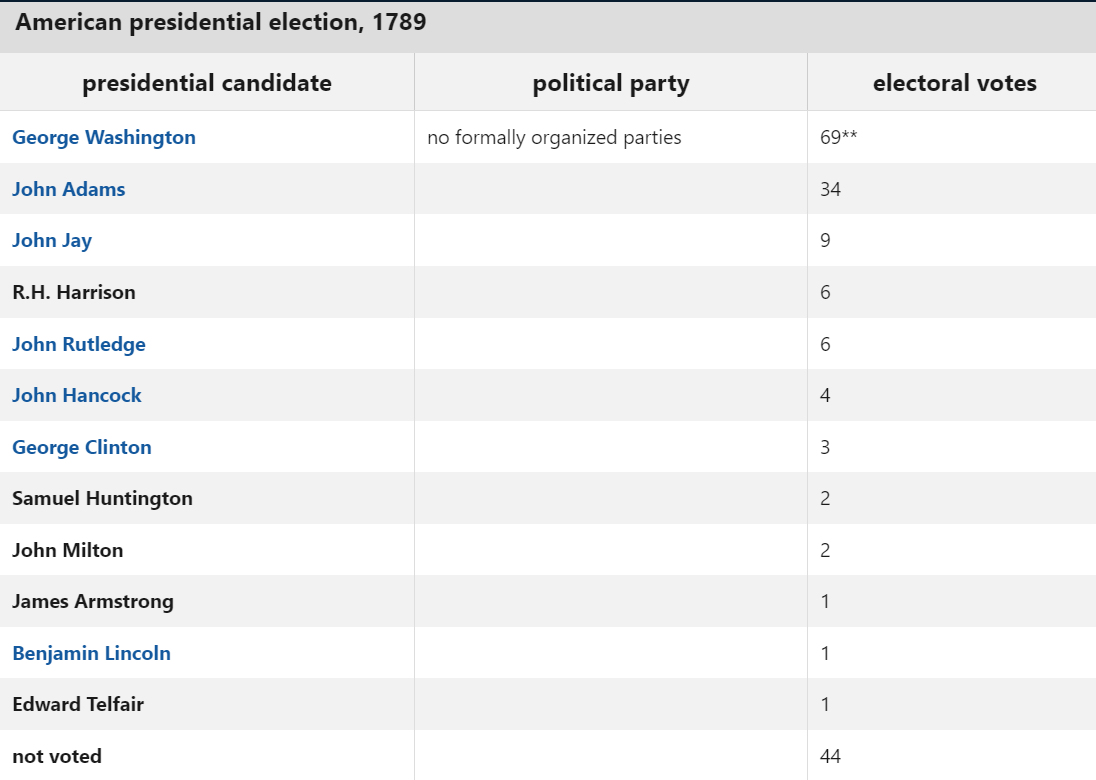Did you know that after the 1787 Constitutional Convention, George Washington's presidency was almost certain? As the respected commander of the Continental Army, he earned a high level of respect for his leadership. After Congress approved the Constitution in July 1788, states had until January 7, 1789, to choose electors who would vote one month later. Washington was the favorite, despite his reservations.
On February 4, 1789, electors from ten states cast ballots; New York, Rhode Island, and North Carolina did not participate. John Adams was chosen vice president with more than half of the vote, but Washington received the votes of all 69 electors.
Notified by Congress, Washington departed Mount Vernon on April 16, 1789, and arrived in New York City on April 30. Towns and villages greeted him with flags, speeches, and triumphal arches as he traveled. In a specially constructed barge adorned with red, white, and blue decorations, he crossed the Hudson River.
At the inauguration event on Wall Street, the audience cheered as Washington took the oath on the balcony of Federal Hall. He mirrored European court attire by donning a brown American-made suit, white stockings, and a sword.
The Outcome of the 1789 Election
The table displays the outcome of the 1789 U.S. presidential election-

The Uncontested Hero: George Washington
George Washington was an obvious contender for President in the 1788-1789 election. Because he was so popular, no one dared to confront him. But, who was his running mate?
Back then, there were no official political parties. However, John Adams became a prominent personality and stood for Vice President. Adams, who would eventually become the second President, finished second and became Washington's Vice President.
Fast Forward to the 1792 Election
George Washington chose to run for a second term, and his prestige was so great that there was virtually no competition. However, this time there were a few extra players on the pitch.
Washington still had John Adams on his side, running for Vice President. However, we see the birth of political groupings, but not fully structured parties as we know them today.
- George Clinton (an Anti-Federalist) made a bid for the presidency.
- Thomas Jefferson also received some electoral votes but wasn’t actively campaigning.
Despite these names, Washington was easily reelected, continuing his role as a unifying figure for the young nation. John Adams remained the Vice President.
Major Events around 1789 Elections
America's government began to take shape in April 1789 when the House and Senate chose their officials. George Washington was sworn in as president and John Adams as vice president on April 6. Adams took office on April 21st, and on April 30th, in Federal Hall, came the momentous inauguration of George Washington.
- April 1, 1789: The House of Representatives established a quorum and legally elected all of its officials.
- On April 6, 1789, the Senate formed a quorum and chose its officials.
- On April 6, 1789, the House and Senate gathered to tally the Electoral College ballots and elected George Washington as President and John Adams as Vice President.
- On April 21, 1789, John Adams was installed as the United States' first Vice President.
- The first inauguration of George Washington as President of the United States of America took place on April 30, 1789, in Federal Hall in New York City.
- On January 8, 1790, President George Washington delivered the inaugural presidential speech, often known as the first State of
- June 20, 1790: The Compromise of 1790 is reached; James Madison agrees not to oppose the federal absorption of state debts; Alexander Hamilton agrees to accept the site of the national capital in the South.
A Note on Political Factions
It's important to remember that the terms "Federalist" and "Anti-Federalist" employed by Washington were not the same as those used by succeeding political parties. They were more comparable to informal factions than official parties, as we know them now.
As a result, even if there wasn't the intense rivalry that we see in today's elections, George Washington's elections laid the groundwork for the political framework that would later emerge in the United States.
Comments
All Comments (0)
Join the conversation